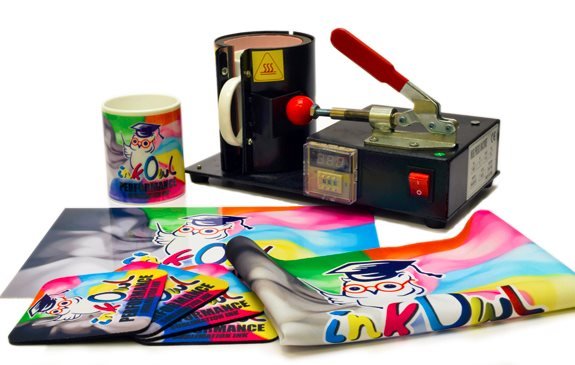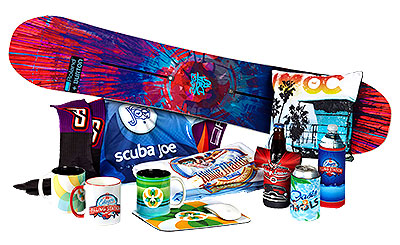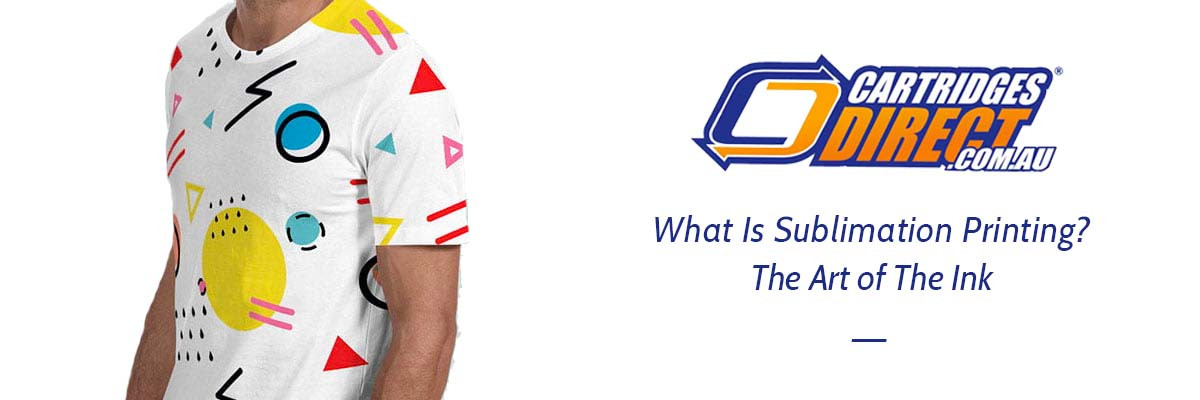What Is Sublimation Printing? The Art Of The Ink
So you’ve created a work of art that you want the world to see. Print it on paper and all you can do is hang it on the wall or bind it in a book. But use sublimation ink in a sublimation printer and you can print your original designs on mouse pad, wear it on a t-shirt, let others drink it in from a mug, or give it real depth when printed on any 3D object you want. The process of sublimation takes printing beyond the limits and into a new dimension. It takes everyday printing into the realm of arts and crafts.
But what is sublimation printing? And how do you get started when looking to use this phenomenal printing technology and its methods right from the comfort of your own home? We’ll be talking all things sublimation below, so read on to unearth some top tips and tricks to becoming a successful graphic designer using the sublimation printing technology at your disposal.
What is sublimation printing?
In the simplest terms, sublimation printing is the process used for transferring printed imagery or graphics to a selection of different materials, including fabrics from clothing, ceramics, plastics, and other surfaces. The process of sublimation involves printing a two-dimensional design using sublimation ink onto special sublimation paper. This design can then be transferred to other surfaces by applying heat onto the sublimation print you’ve produced.
The process of sublimation is quite simple and requires very little preparation to master. All that’s really needed is the sublimation printing paper, sublimation ink cartridges, and of course, a printer that possesses sublimation printing capabilities.
What are sublimation printers?
Sublimation printers aren’t usually printers that are used specifically for sublimation alone. In fact, virtually all modern Epson EcoTank printersare sublimation printers as well, specifically because they use the piezoelectric printhead technology that is used for the process of sublimation printing.
There are generally two types of printing technology used in the design of modern inkjet printers: ‘Bubble Jet’ and ‘Piezo Crystal’ printing. With ‘Bubble Jet’ printing, printer ink can be heated to form a bubble which is then forced through the nozzle of the printhead. Contrary to this, piezoelectric printing uses a crystal that is vibrated at a frequency high enough to pressure the ink through the nozzle of the printhead, hence the term ‘Piezo Crystal’ printing. Piezoelectric printers don’t use heat during their printing process, which allows for the sensitive sublimation ink to be printed right onto sublimation paper without risks of the ink becoming runny and imprecise through overheating.
There is a large range of Epson EcoTank printers available here at Cartridges Direct that are more than suitable to use for the process of sublimation printing, with some of our bestsellers being the Epson ET2710, Epson Photo ET8550 and the Epson Expression Premium ET7750. As Epson EcoTanks are generally All In One printers, that will not only print (with some being able to print in A3), but scan and copy, and in some cases fax as well. In essence, your selected sublimation printer will also prove to be a fantastic and welcome asset to any home or office space with a wide variety of printing needs.

How does sublimation ink different from normal ink?
Although ink used in the sublimation printing process is commonly referred to as sublimation ink, in truth this substance is really a sublimation dye. So what’s the difference? In simple terms, ink is a liquid containing pigment that can be printed on the surface of the material, whilst a dye impregnates the material it is printed on and becomes a part of it. The sublimation dye process needs two additional processes; heat and pressure. The dye changes from a solid to a gas with these processes, causing it to become part of the material rather than a layer on top. This makes it permanent, so designs transferred onto materials using sublimation printing processes, will not fade with frequent washing. A pigment ink, however, will soon wash away and fade as the ink sits directly on the surface of the materials being washed.
Sublimation inks come in the familiar cyan, magenta, yellow and black colours (CMYK) just like normal printing ink. Izumi sublimation inks manufactured in Japan, are ideal sublimation inks for any owners of Epson EcoTank printers who are looking to dabble in sublimation printing. These specialist sublimation inks come in 100ml bottles, making them the perfect size for Epson EcoTank printers.
As part of the sublimation print process will involve heating the sublimation ink to a high temperature, the process of transferring prints to materials can often generate smoke, which can cause alarm for first-time sublimation printers. As Izumi sublimation inks are water-based, they are naturally odour and smoke-free, ensuring that your first experiences with sublimation printing go smoothly and with minimal hassle.
It is important to note that normal printing ink and sublimation ink aren’t interchangeable nor can they simply be swapped out of your printer between regular and sublimation printing jobs. When changing from your printer ink cartridge to a sublimation ink cartridge, you will also need to flush out or clean the entire ink system of your printer, including the ink reservoirs, ink lines, and print heads. This is due to the contrasting molecular make-up of these two ink materials. Failing to flush out your print heads and ink reservoirs can cause inks to become contaminated, which can then result in streaking on paper, ink clotting, and other pesky characteristics of messy printing jobs.
How to print on sublimation paper?
As we mentioned earlier, your sublimation ink will be printed onto a special type of paper so that it can then be transferred onto whatever material you’re looking to transfer your final print to. Known as sublimation paper, it is essentially a sheet of ordinary printing paper coated with polyester. Sublimation paper is generally just as flexible as ordinary paper, and your printer will print onto the sublimation paper you provide just as if it is normal paper. The polyester coating then holds the ink on its surface until it is transferred across to its second layer of printer paper.
It’s important to note that printing your design onto your sublimation paper is not the final step in the sublimation process as this transferral onto paper is by no means the final image, but one that will be transferred onto the surface you intend to place your design on. As a result, any words and images will need to be reversed when printed onto the sublimation paper so that they appear as they should on your desired medium.

What materials can I transfer sublimation prints on?
So you’ve created the design, printed it onto the sublimation paper, and now it’s time to apply it to whatever it is you want to decorate. The sublimation ink can be applied to a huge range of materials including but not limited to glass, ceramics, aluminium, plastic and fibreglass.
There is a wide range of ‘blanks’ available; objects such as mugs, cups, plates, saucers, glassware, even mouse pads, that are just plain white and are ready for your designs to be printed on them.
Then there are fabrics, things such as plain T-shirts, scarves, caps and all sorts of clothing which contain polyester. Due to the polyester-based process of sublimation printing, pure cotton is unfortunately not the most suitable medium when it comes to designing clothing using at-home sublimation printing methods.
To get the ink to release its gas from the sublimation paper onto the end product, both heat and pressure need to be applied. This calls for a heat press as the sublimation paper needs to be pressed tightly against the surface and heated to at least 200C. That’s far hotter than a domestic steam iron, so something a little more elaborate is called for.
Fortunately, there are plenty of heat presses available at reasonable prices. The most common is the flatbed which is ideal for T-Shirts and other flat objects. But for the discernible hobbyist, a far more versatile heat press that can print onto 3D objects is an even better choice. They can be 5-in-1, 8-in-1 or even 15-in-1 presses equipped with attachments that will print onto a whole array of differently shaped objects.
Sublimation printing roundup.
Whether you want to decorate your world your way with your own unique designs or are looking to share your creative flair and knack for design at a commercial scale, sublimation printing can provide you with an abundance of opportunities to experience both personal enrichment, and professional development.
Be sure to check out our blog for more printing tips and tricks for printer users from all walks of life, or contact our friendly team if you’d like more information on any of the sublimation printers we offer here at Cartridges Direct
Explore Popular Articles
-
Best Desk Accessories For Staying Organised & Efficient
5th Dec 2025In a world where so many of us are constantly juggling emails, to-do lists, deadlines, and documents
-
Why is My Printer Ink Smudging? — Key Tips & Solutions
5th Dec 2025If your prints keep coming out smeared, streaky, or wet to the touch, then you are not alone. Ink sm
-
Sublimation vs. Inkjet: Which Printer Is Best For Artists?
27th Nov 2025Sublimation vs. Inkjet: Which Printer Is Best For Artists? Artists today have more printing options




